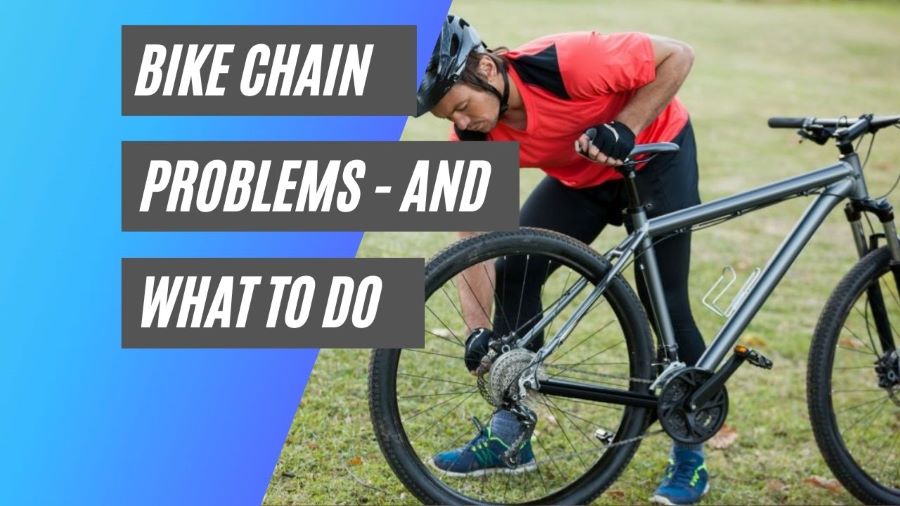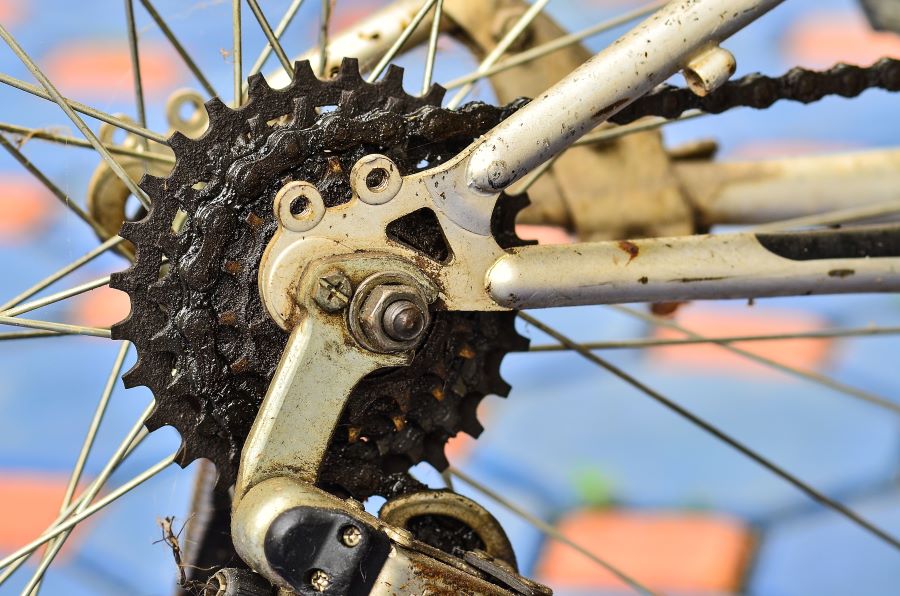This post may contain affiliate links. If you click an affiliate link and make a purchase, I may earn a commission. Also, as an Amazon Associate, I earn from qualifying purchases.--
I’ve ridden bikes for several decades, and in that time I’d say 95% of the maintenance time I’ve ever spent on them has been on sorting out issues with the chains.
The most common bike chain problems are jammed, broken, or slippery chain, skipping chain, stiff or misaligned chain, etc.
In this guide, I’m going to talk about the 9 most common bike chain problems that pretty much all riders might face occasionally, and exactly what to do to sort the problem out. Pretty much any bike chain issue is fixable!
Let’s dive in…

9 Common Bike Chain Problems and Their Fixes
1. Jammed Chain
One of the most typical problems with a bike chain is jammed chains.
When the chains get jammed, they make it difficult for the rider to move the bike forward, making it impossible for them to even take their bike to the repair shop.
How to Fix It?
There may be multiple reasons for the chains to get jammed but one way to fix it is to check the chainrings for any sign of wear. If the bike chain is broken, damaged, or bent, you may have to remove the bad chain link and replace it with a new one.
You can determine whether the bike chain is broken or bent by counting the chain links in the bike and measuring the length of the chain. A typical bike chain has 12 rings and must be exactly 12 inches in total length.
2. Slippery Chain
If you are riding on your bike and you can’t get past a few feet because your chain keeps falling off, it may be because the chain is either too loose (Hub or Fixed-gear bicycles), or the derailleurs keep moving the chain off the cogs due to poor adjustment.
The chain slip usually happens when you change the gears in your bike or ride at high speed.
How to Fix It?
If you have a hub or fixed-gear bike, you can tighten up the loose chain by yourself.
All you need is a wrench to loosen the nuts on the axle of the rear wheel. Next, you will pull back the wheel while keeping it in a central position in the bike’s frame. Retighten the axle bolts and you are done.
It is easier to take care of this problem if your bike has a tensioning adjustment. You can just turn the screw to adjust the tension in your chain according to your choice.
But if you have a bike with derailleurs, the limiting screws will need to be adjusted to tighten the bike chain and prevent it from slipping during your rides.
Limiting screws decide the extreme positions of the derailleurs and are often marked with an “H” (how will the derailleur travel from the bike’s frame) and “L” (how close to the bike’s frame will the derailleur move).
If your bike chain tends to slip on the inner side of the cog, turn over the “L” a couple of times in a clockwise direction.
Whereas, if your bike chain slips off towards the outer side, twist the “H” in a clockwise direction. Play around with both the screws until your bike runs smoothly without its chain slipping off. (Source)
3. Gear Jumping
Another one of the basic issues seen commonly in bikes is their inability to change gears smoothly and properly.
There are many possible answers as to why the bike chain does that but often it is due to the accumulation of dirt or a poor adjustment of the back derailleur.
How to Fix It?
The maintenance of your bike is extremely important and a clean, well-oiled chain is less likely to cause problems and jump gears.
To clean your bike’s chain, first, brush it with a degreaser, remove the caked dirt, wash it with soap, and then apply a lubricant to the chain generously.
If your chain continues to skip gears after you have cleaned and lubricated it, you may want to check and adjust the position of the derailleur.
If your chain is having trouble shifting towards the spokes, you will need to turn the cable barrel adjuster in a clockwise direction.
Whereas if your chain has a problem moving away from the spokes, fine-tune it in a counter-clockwise direction. Adjust the derailleur half a turn at a time until the shifting is even.
4. Broken Chain
Imagine you are riding your bike on your favorite track, having the time of your life, when suddenly the chain on your bike breaks and your bicycle jerks to a stop.
You will need to know how to fix a broken chain, at least temporarily, until you can find a bike repair shop. To follow these steps, you will need a chain-breaking tool and a lot of elbow grease.
How to Fix It?
First, you will need to remove the broken links from the bike’s chain and push in a pin until all the links in the chain come apart.
Make sure to leave the pin in that part of the bike’s chain while you remove the broken section and reconnect the chain with the pin. Push in your pin to secure the chain and test it for stiffness and strength.
Another way for you to fix your bike’s broken chain is by keeping a spare quick link with you. This way you can replace the broken links with the spare links and snap them into place for a smooth ride.
Keep in mind that these fixes are only temporary, and you will have to get the broken chain replaced before your next adventure.

5. Skipping Chain
Often when you buy a new bike, the cables tend to stretch which causes the bike’s chain to skip during the ride. These cables usually stretch in newer bikes in the first few rides or sometimes in older ones too, depending on the use of your bike.
These cables are responsible for managing and opening the derailleur, which is used to change gears during bike rides.
But when these cables get destroyed, broken, or overstretched, the bikes are unable to switch gears, which makes the bike chain skip.
How to Fix It?
By adding tension to the bike’s cables, one can avoid the cables stretching in the first place.
But if your cables have stretched and are causing your bike’s chain to skip, you can move the chain to the smallest ring on the rear wheel, and the middle and larger rings to the front derailleur.
Try this sequence by pressing the shifter.
If the chain does not move the gear up, more tension can be added to the chain. Then turn your barrel adjuster that is placed on the opposite side of the brake lever and hosts the brake cable.
Press and adjust your shifter until your chain moves up the gear and keep going until your bike’s chain has been fine-tuned. The same process can be repeated for the front derailleur as well.
6. “Clunking” Sound
The chains of our bikes bear most of the force of our rides, especially if the bikes are used for mountain biking, racing, or on generally rough terrains.
If you are experiencing a sudden “clunk” sound coming from your bike after each pedal stroke, your crank might be loose or worn from where it is attached to the bottom bracket.
How to Fix It?
If your bike is making clunking sounds, there could be multiple things wrong with the bike.
The first thing you can do is to tighten the cranks. But if the noise continues, you can replace the worn cranks, try a thread-locker on the bolt, or see if the pedal cage has cracked.
If all of these things are in order, you may want to check the pedal for worn axle bearings and replace those if loose.
7. Stiffness in Bike Chain
If you are amongst the riders who use their bikes once or twice a year and have been experiencing some stiffness in your bike during rides, your bike may be in dire need of a deep clean.
Many times, the bikes kept mostly in our garages or stored in our tool sheds gather dust and dirt which sticks to the grease on the chain and compromises the efficiency of the bike.
These bikes are also left out without any proper maintenance, which can cause the bike’s chain to gather rust. This is one of the biggest reasons for stiffness and gear jumping in bikes.
How to Fix It?
A clean, maintained, and rust-free chain runs smoothly and efficiently.
To deep clean your chain, remove it from the bike and scrub it with soap water until all the dirt and grease have been removed. Clean out your crank and cassette while the chain dries and then properly and generously lube your chain before installing it back.
Spin the pedal a few times so that the lube is soaked into the pins and rollers of the chain.
Now, for the last part, take a clean cloth and soak up the access lube from the chain to avoid dirt from accumulating on the chain. Moreover, if you have an incredibly rusty bike chain, you will have to replace that with a new one.
8. Misaligned Chain
Have you ever gone biking and can’t help but hear the constant clicking clacking sounds coming from the bike’s chain?
There may be quite a few reasons for your bike to be making such sounds. It may be because of a broken link in the chain, faulty derailleurs, or a misaligned bike chain.
A bike chain can get misaligned by a lot of things such as poorly placed spacers, wrong sized wheels, sprockets, and chainrings, or a non-centered rear wheel.
How to Fix It?
It is ideal for you to get your bike’s chain realigned by a professional, but for a temporary fix, shift your bike to the lowest front gear with the help of the left shifter. This will make the chain ride on the largest chainring.
Keep pedaling until all the links fall into place, and the chain realigns itself to the chainrings.
9. Slipped Derailleur
If you are having trouble shifting your gear into the biggest chainring, you may have a slipped front derailleur. This might cause the chain to get jammed between the cage of the derailleur and the chainring.
How to Fix It?
To fix a slipped front derailleur, loosen the derailleur, shift it up into place and tighten.
Try this multiple times until the derailleur clicks into place and can shift gears properly.
To check if the derailleur is shifting into the biggest ring, move to the smallest ring and make sure that your bike is in the first gear. (Source)
Shift gear with your shifter and make sure the derailleur shifts into the middle ring on the first click.
If it shifts into the middle ring but not in the largest one, you may have to adjust the high-gear limit screw until the derailleur smoothly shifts gears into the largest chainring.
Do this entire process while you are moving the pedal to avoid any misalignment.
The Final Word
If you are uncertain of your abilities to fix bike chain problems by yourself, it would be a good idea to get it checked out by a professional bike repairer. Most of the problems of bike chains can be solved by replacing the old chain with a new one.
Time is money, so if you can solve the problem quickly with a new chain, and a lot less grease on your hands, why not?
